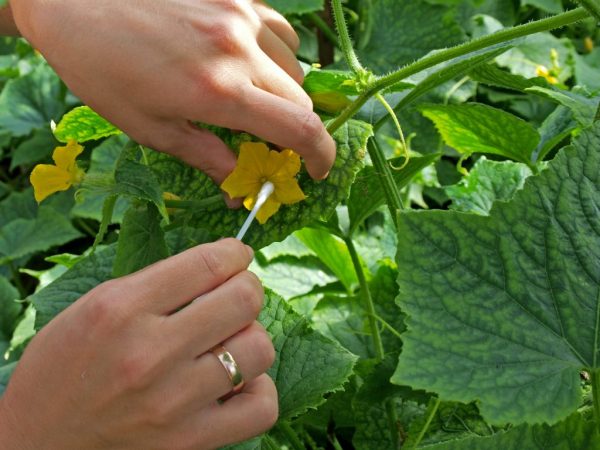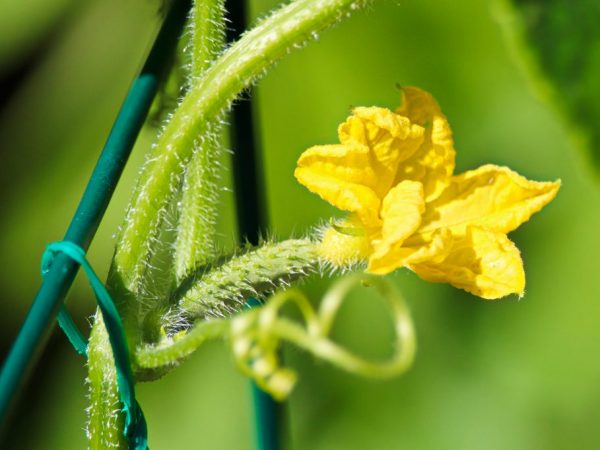How to pollinate cucumbers yourself
Some gardeners grow vegetables not only on their personal plot, but also in an apartment, trying to create acceptable conditions for plant growth in winter. When cultivating, it is important to know how to pollinate cucumbers at home, because it is not possible to launch insects into an apartment for this purpose, and without pollination, you cannot get the expected harvest either at home or in a greenhouse.

Self pollination of cucumbers
Why do cucumbers need pollination
The main task of pollination of cucumber seedlings at home and in the greenhouse is the formation of ovaries, after which the cucumber fruits are obtained. The essence of this process is the transfer of pollen from male inflorescences to female ones. If in nature insects are involved in the pollination process of vegetable crops, then in a closed room, artificial pollination of cucumbers at home is manually transferred to a person.
Pollination rules
Time
You can carry out the process of artificial pollination of cucumbers at almost any time. The time of the procedure directly depends on the cucumber variety and on when exactly the seeds were planted in the soil. Moreover, every gardener knows that the faster to pollinate cucumber inflorescences at home or in a greenhouse, the sooner you can get fresh vegetables from seedlings.
Before the pollination procedure, it is recommended to increase the humidity in the room where the seedlings grow. This can be done by spraying water and a spray bottle, or by placing a container of water near containers with seedlings.
It is preferable to plan the pollination process of cucumbers at home and in the greenhouse not on the first day, when the first inflorescences bloomed on the cucumber seedlings. It is recommended to pollinate flowers 20-24 hours after their opening. The best time for this will be early morning or evening, especially cloudy weather, when the bright sun does not shine through the window. If it is sunny outside the window, you should create a shadow in the room.
Temperature
When carrying out pollination of cucumber inflorescences, the ambient temperature is of no small importance. Compliance with the required thermal regime increases the chances of the formation of ovaries, increasing the number of newly appeared inflorescences. The most optimal indicators for pollination are considered to be from 24 ° C to 27 ° C.
It is recommended to pollinate the inflorescence at a humidity of 70%. When the moisture level is below the recommended level, the pollen dries up. With an excessive increase in humidity, the pollen becomes damp and sticks together.
Exceeding the required temperature threatens the pollen with the loss of its fertilizing properties and, as a result, the loss of the future harvest of vegetables. A decrease in the thermal degree below the recommended level, although it preserves the pollination process itself, however, loses its qualitative characteristics: cucumbers grow small.
Top dressing
Feeding can increase the efficiency of the formation of ovaries at home with proper pollination.For the mineral nutrition of the cucumber culture, it is necessary to select ready-made fertilizers, among the components of which are phosphorus, potassium and urea. Urea is especially important for the development of hearths: it increases the number of cucumber ovaries.
At the same time, using top dressing, you can not stop at collecting the first crop, but try to stimulate a new stage of flowering in plants. To do this, it is enough to lower the temperature by 7-10 points and apply fertilizing complexes.
Differences between male and female inflorescences

Pollination must be done correctly
In order to properly carry out the pollination procedure for cucumbers at home, it is important to know the main differences between female and male inflorescences, which will allow you to determine where to get pollen from and where to move it.
Location
If the male inflorescences are located mainly on the stem of the cucumber crop near the main stem of the plant, gathering in small groups of 5-7 inflorescences, then the female flowers grow one at a time and, as a rule, are formed on the lateral shoots. Moreover, male flowers are often called barren flowers.
The cucumber crop belongs to the monoecious variety, the flowers of both sexes of which form on the same plant at the same time.
Appearance
Externally, single female inflorescences differ from male ones by the presence of a compacted base, which is similar to a small cucumber.
Pollination by a flower
Simple hand pollination of cucumbers is done in the morning. The principle of pollination is to cut off male flowers and attach them to female ones.
1.To this end, the still unblown buds are isolated a day before opening, covering with gauze or a paper cap. This is done so that insects that accidentally enter the room cannot interfere with the future process. Collecting pollen from male inflorescences will require 2 times more than female flowers.
The male flower opens for a day and subsequently withers, while the female one can be pollinated within 2 days.
2. A day later, the protective coating is removed from the inflorescences and the male barren flowers are plucked from which the petals located near the corolla are cut off. It is the corolla with pollen on the anther and stamens that lightly touch the pistil of the female inflorescence.
When not all seeds are pollinated and there is not enough pollen, the incompletely pollinated rudiment of a female flower withers and falls off.
3. With a sufficient number of male barren flowers, the corollas are left for some time directly in the female flower. In order not to get confused which inflorescences have already been pollinated, it is recommended to mark them, for example, with a simple thread.
Pollination with a brush
You can pollinate cucumbers at home without cutting off the male barren flowers, but using a simple artistic brush. This is also a fairly effective method. A soft bristled brush is recommended.
1. The process of pollination with a brush assumes a careful collection of pollen from the male inflorescence, while the villi of the brush must be absolutely dry, otherwise all pollen that gets on the brush will remain on its bristles.
Each female inflorescence is processed with male flowers.
2. A brush with yellow pollen collected on the bristles is brought neatly to the female inflorescence, spreading the material collected from the male anther and stamens over the surface of the female pistil.
3. The pollinated flowers are covered with paper caps, which are removed when it becomes noticeable that the ovary has formed and begins to increase in size.


